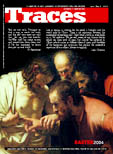
Traces N.3, March 2004
Mary, Jesus’ First ContemporaryWhen he spoke at Minneapolis in the course of the presentation of Fr Giussani’s book Why the Church?, the new Archbishop of Boston, Sean O’Malley, quoted the British weekly magazine The Economist, which dedicated its front page to Our Lady and to the devotion she enjoys on the part of Jews, Christians and Muslims. All the media have their spotlights on the opening of Mel Gibson’s film The Passion, which recounts the last hours of Christ’s passion. In the Italian daily La Repubblica, the writer Pietro Citati dedicated a long article on the culture page to Jesus’ crucifixion as narrated in the Gospels. Carlo Ossola, member of the Collège de France, gave the last lecture of a series that found gathered in Paris today’s chief poetry scholars, on the theme of the representation of the Virgin in Dante’s hymn in his Paradiso.
It seems that the figure of Christ and His Mother are living a moment of great popularity. It is certainly not the first time that culture, the media and the cinema focus on this subject. But, in recent years, it seemed that the interest for the religious phenomenon was content to paint even the Christian faith as a confused feeling about existence, like a variation of the New Age, or at best as a philosophy of behavior.
Mary and Jesus, instead, continue to arouse interest. However confusedly, we can understand that there, in the historical reality of Jesus and in that of Her who generated Him, lies the origin of the greatest revolution in history. Therefore, there is no halt in the attempts to make those figures closer, more contemporary to our own day, and thus nearer to our joys and our sorrows–to have them here, Jesus and Mary, in the day-to-day events, and in the possible distress; to have them here as a renewal for man, as a continuous re-birth.
What qualifies the faith is being contemporary with Christ; acknowledging a Presence. If this weren’t the case, then faith would be reduced to a subjective effort, however pious, of the imagination. Kierkegaard understood this clearly. In his Diary he wrote, “The only ethical relationship one can have with greatness (thus also with Christ) is contemporaneity. The relationship with a dead man is an aesthetic relationship: his life has lost its sting, it doesn’t judge my life, it permits me to admire him… and it lets me live in quite different categories–it does not force me to judge in a decisive sense.”
Imagination tires, whereas friendship renews. The method with which Christ makes Himself contemporary is the Church, her life of sacraments and friendship.
Existentially, the meaning of the Church is grasped through the encounter with a friendship. The summit of the Church’s life is precisely this. For from the time a tiny group would meet under Solomon’s Porch in Jerusalem, the friendship amongst the Christians has always been the motive for scandal or for conversion for those who saw them, with an evil heart or an open and free heart. Facts of friendship are what has renewed and renews the Church’s face, and the face of her communities throughout the world.
It’s a question of a friendship that’s different from all others, not based on interest or on temperaments that “correspond;” a friendship that does not censure, that is not scandalized by evil; that is concerned with nothing else but that in everything–from one’s personal life to cultural, social and political commitments–it may be easier to “let our own yes happen” (as Archbishop O’Malley said in Minneapolis) in the presence of God. As it happened to Mary, Jesus’ first contemporary.